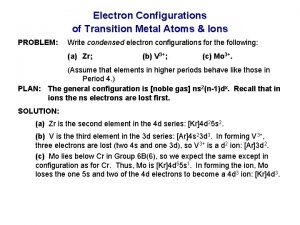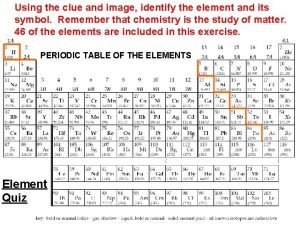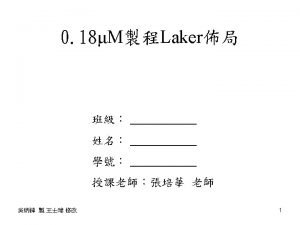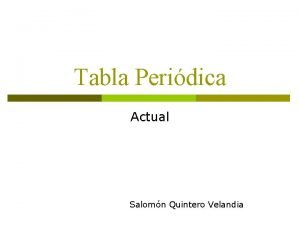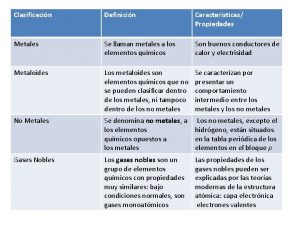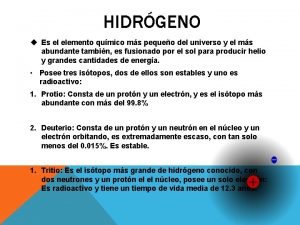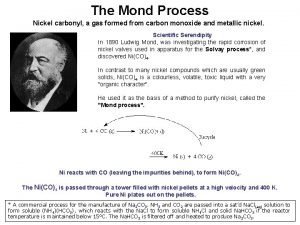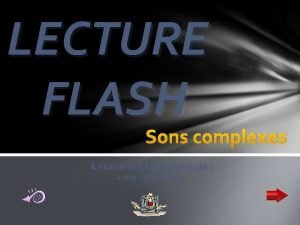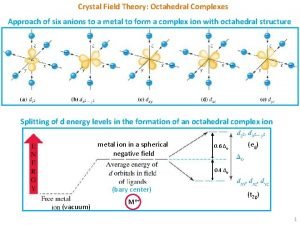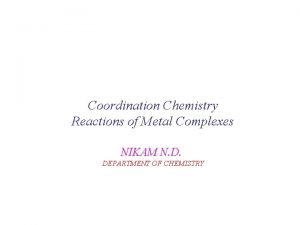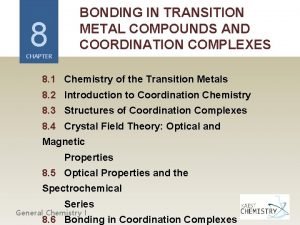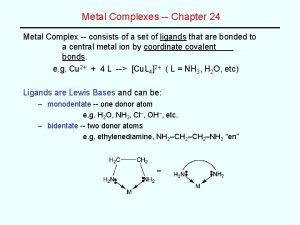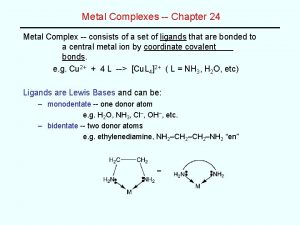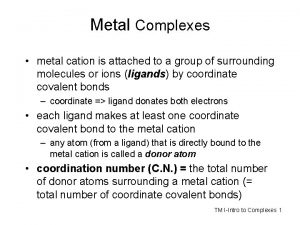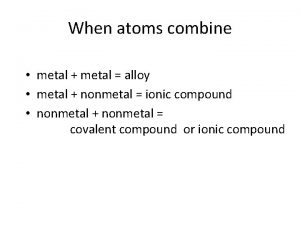Chapter 23 Sections 2 4 Transition Metal Complexes








![A. B. C. D. [Fe(H 2 O)4]3+(aq) + SCN–(aq) [Fe(H 2 O)3 NCS]2+(aq) + A. B. C. D. [Fe(H 2 O)4]3+(aq) + SCN–(aq) [Fe(H 2 O)3 NCS]2+(aq) +](https://slidetodoc.com/presentation_image_h2/caa6b4e5db6957ce0a6792118b9e8d1d/image-9.jpg)






















- Slides: 31

Chapter 23 Sections 2 -4 Transition Metal Complexes © 2012 Pearson Education, Inc.

Complexes • Commonly, transition metals can have molecules or ions that bond to them. • These give rise to complex ions or coordination compounds. Transition Metals © 2012 Pearson Education, Inc.

Ligands The molecules or ions that bind to the central metal are called ligands (from the Latin ligare, meaning “to bind”). Transition Metals © 2012 Pearson Education, Inc.

A. Yes. Ammonia is the Lewis acid. B. Yes. The metal cation is the Lewis acid. C. No. Ammonia is a neutral molecule and cannot can not accept electron density from a Lewis base. D. No. The metal cation cannot accept electron density from a Lewis base.

Coordination One of the properties that has led to the fascination with complexes and transition metals is the wide range of stunning colors found in them. Transition Metals © 2012 Pearson Education, Inc.

Werner Theory The Swiss chemist Alfred Werner deduced that there was a difference between the oxidation number of a metal and the number of ligands it took on, which he called the coordination number. Thus, although the first two complexes in the table above each have 3 chlorines, in the first all three serve as anions, while in the second one of the chlorines is tightly bound to the cobalt and the other two are counterions. Transition Metals © 2012 Pearson Education, Inc.

Sample Exercise 23. 1 Identifying the Coordination Sphere of a Complex Palladium(II) tends to form complexes with coordination number 4. A compound has the composition Pd. Cl 2 · 3 NH 3. (a) Write the formula for this compound that best shows the coordination structure. (b) When an aqueous solution of the compound is treated with excess Ag. NO 3(aq), how many moles of Ag. Cl(s) are formed per mole of Pd. Cl 2 · 3 NH 3? Solution Practice Exercise Predict the number of ions produced per formula unit in an aqueous solution of Co. Cl 2 · 6 H 2 O.

The Metal–Ligand Bond • The reaction between a metal and a ligand is a reaction between a Lewis acid (the metal) and Lewis base (the ligand). • The new complex has distinct physical and chemical properties. Transition Metals © 2012 Pearson Education, Inc.
![A B C D FeH 2 O43aq SCNaq FeH 2 O3 NCS2aq A. B. C. D. [Fe(H 2 O)4]3+(aq) + SCN–(aq) [Fe(H 2 O)3 NCS]2+(aq) +](https://slidetodoc.com/presentation_image_h2/caa6b4e5db6957ce0a6792118b9e8d1d/image-9.jpg)
A. B. C. D. [Fe(H 2 O)4]3+(aq) + SCN–(aq) [Fe(H 2 O)3 NCS]2+(aq) + H 2 O(l) [Fe(H 2 O)4]3+(aq) + S 2+(aq) + CN–(aq) [Fe(H 2 O)5 NCS]2+(aq) + H 2 O(l) Fe 3+(aq) + 3 SCN–(aq) Fe. CN 3 (aq) + 3 S–(aq) [Fe(H 2 O)6]3+ (aq) + SCN–(aq) [Fe(H 2 O)5 NCS]2+(aq) + H 2 O(l)

Coordination Numbers • The number of atoms directly bonded to the metal atom in a complex is the coordination number. Compound Coordination number [Ag(NH 3)2]+ 2 [Co(NH 3)6]Cl 3 6 [Co(NH 3)5 Cl]Cl 2 6 trans -[Co(NH 3)4 Cl 2]Cl 6 cis -[Co(NH 3)5 Cl 2]Cl 6 Transition Metals © 2012 Pearson Education, Inc.

Sample Exercise 23. 2 Determining the Oxidation Number of a Metal in a Complex What is the oxidation number of the metal in [Rh(NH 3)5 Cl](NO 3)2? Solution Practice Exercise What is the charge of the complex formed by a platinum(II) metal ion surrounded by two ammonia molecules and two bromide ions?

Sample Exercise 23. 3 Determining the Formula of a Complex Ion A complex ion contains a chromium(III) bound to four water molecules and to two chloride ions. What is the formula and charge of this ion? Solution Practice Exercise Write the formula for the complex described in the Practice Exercise accompanying Sample Exercise 23. 2.

Coordination Numbers • The coordination number of a metal depends upon the size of the metal and the size of the ligands. • While iron(III) can bind to 6 fluorides, it can only accommodate 4 of the larger chlorides. Transition Metals © 2012 Pearson Education, Inc.

A. B. C. D. NH 3—Zn—NH 3—Pt—NH 3 109. 5° 120° 180° 120° 90° 109. 5° 120° 90°

Geometries: A. B. C. D. C. N. = 4 Octahedral Tetrahedral Octahedral Square planar C. N. = 6 Tetrahedral Octahedral Square planar Tetrahedral

A. B. C. D. Two for both Three for both Four for both Six for both

Common Ligands The table above contains some ligands commonly found in complexes. Monodentate ligands coordinate to one site on the metal, bidentate to two, and so forth. Transition Metals © 2012 Pearson Education, Inc.

Common Ligands Bi and polydentate ligands are also called chelating agents. Transition Metals © 2012 Pearson Education, Inc.

A. Bidentate ligand B. Monodentate ligand

Chelates in Biological Systems • There are many transition metals that are vital to human life. • Several of these are bound to chelating agents. Transition Metals © 2012 Pearson Education, Inc.

Chelates in Biological Systems • For instance, the iron in hemoglobin carries O 2 and CO 2 through the blood. Transition Metals © 2012 Pearson Education, Inc.

A. B. C. D. On the protein group On the heme group On the NH group Where O 2 binds

Chelates in Biological Systems • For instance, the iron in hemoglobin carries O 2 and CO 2 through the blood. • Carbon monoxide and cyanide are poisonous because they will bind more tightly to the iron than will oxygen. Transition Metals © 2012 Pearson Education, Inc.

A. B. C. D. 420 nm 500 nm 610 nm 650 nm

A. It has a planar structure that enables the C-H bonds to absorb light in the visible region. B. The C-C bonds absorb light in the ultraviolet region. C. It has conjugated double bonds that absorb light in the visible region. D. It has C-H bonds that absorb light in the infrared region.

Nomenclature in Coordination Chemistry 1. In naming complexes that are salts, the name of the cation is given before the name of the anion. Transition Metals © 2012 Pearson Education, Inc.

Nomenclature in Coordination Chemistry 2. In naming complex ions or molecules, the ligands are named before the metal. Ligands are listed in alphabetical order, regardless of their charges. Transition Metals © 2012 Pearson Education, Inc.

Nomenclature in Coordination Chemistry 3. The names of anionic ligands end in the letter o, but electrically neutral ligands ordinarily bear the name of the molecules. Transition Metals © 2012 Pearson Education, Inc.

Nomenclature in Coordination Chemistry 4. Greek prefixes (di-, tri-, tetra-, etc. ) are used to indicate the number of each kind of ligand when more than one is present. If the ligand contains a Greek prefix or is polydentate, the prefixes bis-, tris-, tetrakis-, etc. are used and the ligand name is placed in parentheses. Transition Metals © 2012 Pearson Education, Inc.

Nomenclature in Coordination Chemistry 5. If the complex is an anion, its name ends in -ate. 6. The oxidation number of the metal is given in parentheses in Roman numerals following the name of the metal. Transition Metals © 2012 Pearson Education, Inc.

Sample Exercise 23. 4 Naming Coordination Compounds Name the compounds (a) [Cr(H 2 O)4 Cl 2]Cl, (b) K 4[Ni(CN)4]. Solution Practice Exercise Name the compounds (a) [Mo(NH 3)3 Br 3]NO 3, (b) (NH 4)2[Cu. Br 4]. (c) Write the formula for sodium diaquabis(oxalato)ruthenate(III).
 What is nephelauxetic effect
What is nephelauxetic effect What is the mulliken symbols for f spectroscopic term in
What is the mulliken symbols for f spectroscopic term in Nonmetal halogen family, atomic mass 35
Nonmetal halogen family, atomic mass 35 Transition metal ion colours
Transition metal ion colours Electron configuration of transition metals
Electron configuration of transition metals Metal ion colors
Metal ion colors Strongest element on earth
Strongest element on earth Venn diagram of solids liquids and gases
Venn diagram of solids liquids and gases Metals vs nonmetals properties
Metals vs nonmetals properties Dp periodic table
Dp periodic table Melting point of nonmetals
Melting point of nonmetals N well pmos
N well pmos Metal and non metal difference between
Metal and non metal difference between Periodic table pure substances
Periodic table pure substances Metals react with nonmetals to form ionic compounds by
Metals react with nonmetals to form ionic compounds by Periodo en quimica
Periodo en quimica Dr terry blanch
Dr terry blanch Propiedades de los metaloides
Propiedades de los metaloides Metals examples
Metals examples Existen tres isotopos naturales del potasio 39k 40k y 41k
Existen tres isotopos naturales del potasio 39k 40k y 41k Monds process
Monds process K complexes eeg
K complexes eeg Freud complexes
Freud complexes Example of labile complex
Example of labile complex Voyelles complexes
Voyelles complexes Uncouplers
Uncouplers δo
δo Inert and labile complexes
Inert and labile complexes Lanthanides have poor tendency to form complexes
Lanthanides have poor tendency to form complexes Spectrochemical series of ligands
Spectrochemical series of ligands La roda maquina simple
La roda maquina simple Phrase complexe
Phrase complexe




